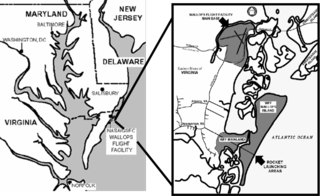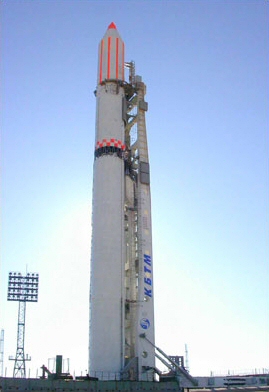Related Research Articles

A sounding rocket or rocketsonde, sometimes called a research rocket or a suborbital rocket, is an instrument-carrying rocket designed to take measurements and perform scientific experiments during its sub-orbital flight. The rockets are used to launch instruments from 48 to 145 km above the surface of the Earth, the altitude generally between weather balloons and satellites; the maximum altitude for balloons is about 40 km and the minimum for satellites is approximately 121 km. Certain sounding rockets have an apogee between 1,000 and 1,500 km, such as the Black Brant X and XII, which is the maximum apogee of their class. Sounding rockets often use military surplus rocket motors. NASA routinely flies the Terrier Mk 70 boosted Improved Orion, lifting 270–450-kg (600–1,000-pound) payloads into the exoatmospheric region between 97 and 201 km.

Wallops Flight Facility (WFF) is a rocket launch site on Wallops Island on the Eastern Shore of Virginia, United States, just east of the Delmarva Peninsula and approximately 100 miles (160 km) north-northeast of Norfolk. The facility is operated by the Goddard Space Flight Center in Greenbelt, Maryland, and primarily serves to support science and exploration missions for NASA and other Federal agencies. WFF includes an extensively instrumented range to support launches of more than a dozen types of sounding rockets; small expendable suborbital and orbital rockets; high-altitude balloon flights carrying scientific instruments for atmospheric and astronomical research; and, using its Research Airport, flight tests of aeronautical research aircraft, including unmanned aerial vehicles.

The Flight Test Range (FTR) at Sonmiani Beach is a rocket launch site in Balochistan, approximately 50 kilometres (31 mi) west of Karachi, Sindh, Pakistan.
The Ghaznavi, is a land-based short range ballistic missile, currently in military service with the strategic command of the Pakistan Army.

The Hatf I is a land-based tactical and battlefield range ballistic missile, currently in service with the strategic command of the Pakistan Army.

The Abdali is a land-based tactical short-range ballistic missile (SRBM) currently in military service with the strategic command of the Pakistan Army.

Badr-1 was the first artificial and the first digital communications satellite launched by Pakistan's national space authority — the SUPARCO — in 1990. The Badr-1 was Pakistan's first indigenously developed and manufactured digital communications and an experimental artificial satellite which was launched into low Earth orbit by Pakistan on 16 July 1990, through a Chinese carrier rocket. The launch ushered new military, technological, and scientific developments in Pakistan and also provided data on radio-signal distribution in the ionosphere. Originally planned to be launched from the United States in 1986, the Challenger disaster further delayed the launch of the satellite which changed the plan. After the People's Republic of China offered Pakistan to use its facility, the Badr-1 was finally launched from Xichang Satellite Launch Center in 1990 on Long March 2E. Badr-1 travelled at 17,500 miles per hour (28,200 km/h), taking 96.3 minutes to complete an orbit, and emitted radio signals at the 145 to 435 MHz bands which were operated by Pakistan Amateur Radio Society (PARS). The Badr-1 successfully completed its designed life, and a new satellite was proposed to be developed.

The Space & Upper Atmosphere Research Commission, commonly referred to as SUPARCO, is an agency of the Government of Pakistan responsible for the national space program.

Spaceflight as a practical endeavor began during World War II with the development of operational liquid-fueled rockets. Beginning life as a weapon, the V-2 was pressed into peaceful service after the war at the United States' White Sands Missile Range as well as the Soviet Union's Kapustin Yar. This led to a flourishing of missile designs setting the stage for the exploration of space. The small American WAC Corporal rocket was evolved into the Aerobee, a much more powerful sounding rocket. Exploration of space began in earnest in 1947 with the flight of the first Aerobee, 46 of which had flown by the end of 1950. These and other rockets, both Soviet and American, returned the first direct data on air density, temperature, charged particles and magnetic fields in the Earth's upper atmosphere.
Rehbar is a series of sounding rockets launched into the upper atmosphere by Pakistan's Space and Upper Atmosphere Research Commission (SUPARCO). Rehbar-I was the first rocket launched by SUPARCO, on 7 June 1962. Rehbar-I was a two-staged solid fuel rocket.

The Badr-B is the second spacecraft and the first Earth observation satellite launched into Earth orbit on 10 December 2001 at 09:15 by the SUPARCO — Pakistan's national space agency. Badr-B is a microsatellite, with a mass of ~70 kg, and contained the computerized system to conduct the studies on the gravity gradient. Badr-B is a research satellite to explore the upper atmosphere and the near space, and carried a large array of instruments for geophysical research.

The year 1951 saw extensive exploration of space by the United States and the Soviet Union (USSR) using suborbital rockets. The Soviets launched their first series of biomedical tests to the 100-kilometre (62 mi) boundary of space. Several American agencies launched more than a dozen scientific sounding rocket flights between them. The US Navy launched its Viking sounding rocket for the seventh time since 1949, this time to a record-breaking 136 miles (219 km) in August 1951.
For other people with the same or similar name, see Abdul Majid

The Shaheen-I, is a land-based short-range ballistic missile designed and developed by the National Defence Complex and National Engineering & Science Commission.

Space research is scientific study carried out in outer space, and by studying outer space. From the use of space technology to the observable universe, space research is a wide research field. Earth science, materials science, biology, medicine, and physics all apply to the space research environment. The term includes scientific payloads at any altitude from deep space to low Earth orbit, extended to include sounding rocket research in the upper atmosphere, and high-altitude balloons.
Dr. Salim Mehmud, also known as Salim Mehmood, is a Pakistani rocket scientist and a nuclear engineer. He is the former chairman of Space and Upper Atmosphere Research Commission (SUPARCO). He has served as chief scientist at the Defence Science and Technology Organization. Currently, he is the chief Scientific and Technological Advisor at the Ministry of Communications of Pakistan.

The Hatf Program was the classified program by the Ministry of Defence (MoD) of Pakistan for the comprehensive research and the development of guided missiles. Initiatives began in 1986–87 that also received support from Prime Minister Benazir Bhutto in a direct response to India's equivalent program in 1989.
The Pakistan Mission Control Center is a separate command and control and separate mission control center at the Suparco Headquarters in Karachi, Pakistan. The PMCC manages and controls the satellite programme of Pakistan, and controls the nation's unmanned space programme.

German V-2 rockets captured by the United States Army at the end of World War II were used as sounding rockets to carry scientific instruments into the Earth's upper atmosphere, and into sub-orbital space, at White Sands Missile Range (WSMR) for a program of atmospheric and solar investigation through the late 1940s. Rocket trajectory was intended to carry the rocket about 100 miles (160 km) high and 30 miles (48 km) horizontally from WSMR Launch Complex 33. Impact velocity of returning rockets was reduced by inducing structural failure of the rocket airframe upon atmospheric re-entry. More durable recordings and instruments might be recovered from the rockets after ground impact, but telemetry was developed to transmit and record instrument readings during flight.
References
- ↑ Staff (2002-10-04). "Timeline: Pakistan's weapons development". The Guardian. ISSN 0261-3077 . Retrieved 2024-04-23.
- ↑ "Pakistan Nuclear Chronology" (PDF). nti.org.
- ↑ "Suparco". web.archive.org. 2012-10-06. Retrieved 2024-04-23.
- ↑ "Hatf 1". Missile Threat. Retrieved 2024-04-23.
- ↑ "Abdali (Hatf 2)". Missile Threat. Retrieved 2024-04-23.